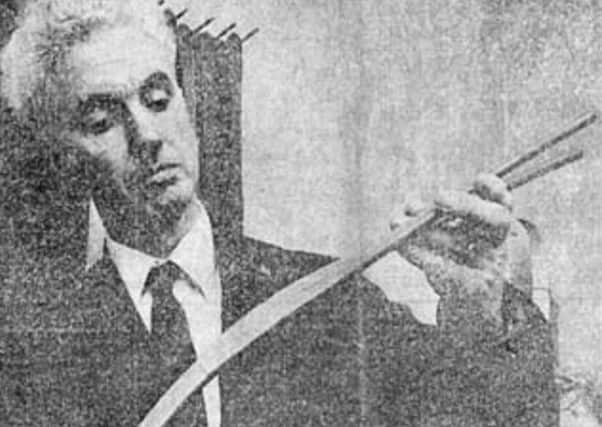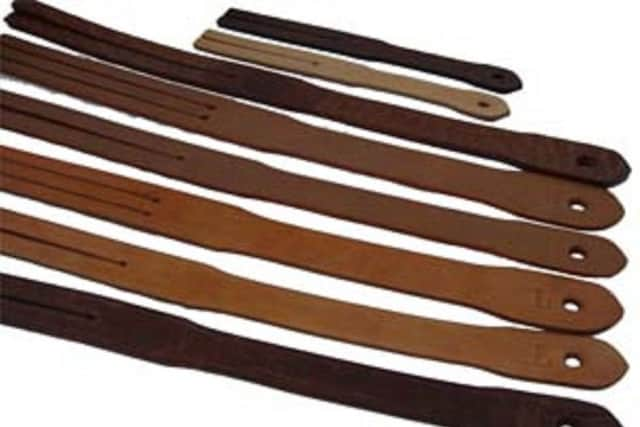Remembering the Lochgelly Tawse


But there is one name for this tool of child punishment that will stick in the mind of many: the Lochgelly Tawse.
Made in the Fife town by two families of saddlers, the Lochgelly Taswe was supplied to schools for just over 100 years with it becoming the belt of choice for teachers.


Advertisement
Hide AdBy mid 20th Century, the town’s John J Dick Leather Goods had an estimated 70 per cent of the schools market in Scotland despite there being at least 30 different manufacturers up and down the country.
What set the Lochgelly Tawse apart was that it was heavier than its rivals.
Margaret Dick, daughter of the late John Dick, said: “The teachers liked this new belt as it was narrower so easier to wield.
“It was firmer so it didn’t wrap around the hand. It was also well made with no sharp edges to cause serious damage.”
Ms Dick, who still makes and sells the Lochgelly Tawse, added: “I remember that the Glasgow schools were supposed to buy from Glasgow suppliers.
“At one point the Glasgow belt was black. We used to get teachers coming up to buy the tawse at Lochgelly and then staining them black so headteachers wouldn’t see them.
Advertisement
Hide Ad“The tawse was a small part of the business although towards the start of term there was always a rush to get them out to the teachers.”
Ms Dick, 54, remembers the belt being used in her school. Indeed, she received “six of the best” after forgetting to bring her gym shorts to school for the third time.
Advertisement
Hide AdSometimes, she would arrive at school with the straps in her schoolbag.
“On occasion, I delivered new ones to the teachers,” Ms Dick added.
According to research by Ms Dick, the Lochgelly Tawse was first made in the town by saddler R.Philp & Son in 1884 with the company later hiring her grandfather, George Dick, as a black saddler and bridle maker.
Mr Dick left the company to set up a firm with his brother in 1908 and around 1924 he started producing the tawse using his own Lochgelly saddler’s stamp.
By 1949, a newspaper article shows that demand for the Lochgelly Tawse was booming with her grandfather reporting a 50 per cent rise in orders.
The report said: “Mr Dick is not inclined to lay all the blame at the door of the children. Factors which he attributes to this increase in his business include the raising of the school leaving age and the larger number of teachers being turned out by universities.
Advertisement
Hide Ad“Another point to be borne in mind is the trend in England to do away with the cane and with a greater number of Scottish school teachers taking up appointments south of the border, the fame of the Lochgelly “correctors” is increasing, as evidenced by the orders which pour into Mr Dick’s shop in Main Street.”
The article describes how each tawse was made from a strip of tanned and curried leather measuring two feet long.
Advertisement
Hide Ad“The leather is then dressed and the tongues cut halfway up the middle. It is these tongues which provide the nip when they strike the erring pupil’s hand.”
Tawse is the Scots word for the thongs of a whip.
By the end of the 1970s, the thicker leather needed for the heavier tawse was harder to source given more intensive farming methods.
Opinion on corporal punishment was also starting to change. Lashes to the hands were administered for ‘offences’ as petty as throwing snowballs or not understanding a new piece of work, according to accounts.
Some who grew up under the threat of the tawse have also recalled being fearful of going to school, with their young years rendered pretty miserable. Others recalled it as an effective deterrent to behaving badly.
Used of the belt in schools in Scotland was prolific. In 1977, 84 per cent of boys and 57 per cent of girls at secondary school claimed to have been belted at primary school.
It was two Scottish mothers who eventually brought about the ban on the belt. Grace Campbell took her case to the European Commission on Human Rights when Strathclyde regional education authority refused to guarantee her 11-year-old son, Gordon, would not be hit.
Advertisement
Hide AdJane Cosans brought a similar case against Fife’s education authority.
After legal deliberations which lasted for six years, their case was successful. By the start of the school term in 1987, its used was wiped out overnight. Private schools followed with the ban 10 years later 1998.
Advertisement
Hide AdMs Dick said he family were “quite glad” when the belt stopped in Scotland’s schools.
“There had been a lot of controversy surrounding it and really, my family were just a saddlers and leather goods manufacturers. We weren’t really into the politics of it all.
“Although, my father’s view was that it was up to the school teachers to decided if they needed it to control their classes.
“He would never provide it for home use, and he was asked to do that, but he wouldn’t supply it for that. We were really quite a pacifist family. My father never lifted a finger to me.”
Ms Dick still makes the Lochgelly Tawse with the heaviest versions selling for £175.
She said: “I still make a few, there is still quite a collectors market. They can go for hundreds of pounds on Ebay.”
Advertisement
Hide AdThe attraction of buying a tawse is not always clear when the orders come in but a portion of the belts are posted to ex-pat Scots.
Ms Dick added: “Recently I sold on to a woman in Holland where none of her friends had heard of a tawse. It was a talking point. She wanted to hang one up in her study. It was something that reminded her of schooling in Scotland.”
